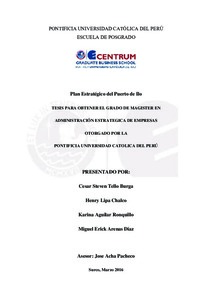| dc.contributor.advisor | Acha Pacheco, José Carlos Benjamín | |
| dc.contributor.author | Tello Burga, César Steven | es_ES |
| dc.contributor.author | Lipa Chalco, Henry | es_ES |
| dc.contributor.author | Aguilar Ronquillo, Karina | es_ES |
| dc.contributor.author | Arenas Díaz, Miguel Erick | es_ES |
| dc.date.accessioned | 2016-11-07T16:45:58Z | |
| dc.date.available | 2016-11-07T16:45:58Z | |
| dc.date.created | 2016 | |
| dc.date.issued | 2016-11-07 | |
| dc.identifier.uri | http://hdl.handle.net/20.500.12404/7430 | |
| dc.description.abstract | La presente tesis desarrolla el Plan Estratégico del Puerto de Ilo para los próximos diez años, con el objetivo de ser el principal puerto de la región sur del Pacífico, a través de la implementación de estrategias propuestas como resultado de analizarlos desde múltiples perspectivas. La metodología empleada consistió en revisión bibliográfica y en visitas a instituciones como: (a) APN, (b) ENAPU, (c) SPCC, y (d) ENERSUR, y (e) TRAMARSA y se siguió el Modelo Secuencial del Proceso Estratégico, mediante el cual se analiza la situación actual con el fin de diagnosticarlo, concluyendo que posee serios problemas de infraestructura y de gestión que lo hacen poco competitivo respecto a sus competidores; Se analizaron puertos exitosos a nivel mundial con el fin de tomarlos como referencia para revisar y adoptar sus buenas prácticas en el planteamiento de estrategias. A través del análisis de los factores externo e interno se identificaron como: (a) fortalezas: la ubicación geográfica e intermodalidad; (b) debilidades: estructura administrativa jerárquica y burocrática, infraestructura obsoleta y limitadas vías de acceso; (c) oportunidad: la integración ferroviaria Brasil – Bolivia – Perú, ejecución y ampliación de proyectos mineros y la diversificación de rutas marítimas de empresas brasileñas y bolivianas; y como (d) amenaza: excesivo tiempo de improductividad por el oleaje y tendencia mundial de circulación de buques de gran tamaño. Finalmente, luego de realizar el análisis competitivo se ha determinado los factores críticos de éxito para elevar su competitividad y con ellos contribuir al desarrollo del país. Las estrategias propuestas se enfocan en: desarrollo de mercado, penetración en el mercado, desarrollo de producto, basado en la concesión del puerto y generación de acuerdos comerciales con empresas de Brasil y Bolivia. Mediante el Balanced Scorecard (BSC) se hará el seguimiento y control de los objetivos a corto plazo permitiendo en el año 2025 ser un puerto productivo y competitivo. | es_ES |
| dc.description.abstract | This thesis develops the Strategic Plan of the Port of Ilo for the next ten years, with the goal of being the main port of the southern Pacific region through the implementation of strategies proposed as a result of analysis from multiple perspectives. The methodology consisted of literature review and visits to institutions such as :(a) APN, (b) ENAPU, (c) SPCC, y (d) ENERSUR, y (e) TRAMARSA and continued Sequential Model of the Strategic Process, where analyzed the current situation with the finality of diagnose it, concluding that has serious problems in management and infrastructure that make it uncompetitive compared with its competitors. This material analyzes worldwide successes ports to take them as a reference to review and choose the best practices in the formulation of strategies. Through the analysis of external and internal factors this thesis identified as: (a) strengths: geographic location and intermodal port; (b) weaknesses: hierarchical and bureaucratic administrative structure, outdated infrastructure and limited access roads; (c) opportunity: the railway integration Brasil – Bolivia – Perú, implementation and expansion of mining projects and diversification of routes maritime from Brazilian and Bolivian companies; and as (d) threat: excessive unproductive time by waves and global circulation of vessels size. Finally, to perform the competitive analysis of the port of Ilo it determined critical success factors required to increase their competitiveness, and they contribute to country’s development. The proposed strategies are focused in the following topics: market development, market penetration, product development, based in the concession of the port and making commercial agreements with the companies in Brazil and Bolivia. The Balanced Scorecard (BSC) will do the supervision and control of the short-term objectives, expecting being a productive and competitive port in 2025. | es_ES |
| dc.language.iso | spa | es_ES |
| dc.publisher | Pontificia Universidad Católica del Perú | es_ES |
| dc.rights | info:eu-repo/semantics/openAccess | es_ES |
| dc.rights.uri | http://creativecommons.org/licenses/by-nc-nd/2.5/pe/ | * |
| dc.subject | Puertos--Perú--Ilo | es_ES |
| dc.subject | Planificación estratégica | es_ES |
| dc.title | Plan estratégico del Puerto de Ilo | es_ES |
| dc.type | info:eu-repo/semantics/masterThesis | es_ES |
| thesis.degree.name | Magíster en Administración Estratégica de Empresas | es_ES |
| thesis.degree.level | Maestría | es_ES |
| thesis.degree.grantor | Pontificia Universidad Católica del Perú. CENTRUM | es_ES |
| thesis.degree.discipline | Administración Estratégica de Empresas | es_ES |
| renati.discipline | 413307 | es_ES |
| renati.level | https://purl.org/pe-repo/renati/level#maestro | es_ES |
| renati.type | https://purl.org/pe-repo/renati/type#tesis | es_ES |
| dc.publisher.country | PE | es_ES |
| dc.subject.ocde | https://purl.org/pe-repo/ocde/ford#5.02.04 | es_ES |






